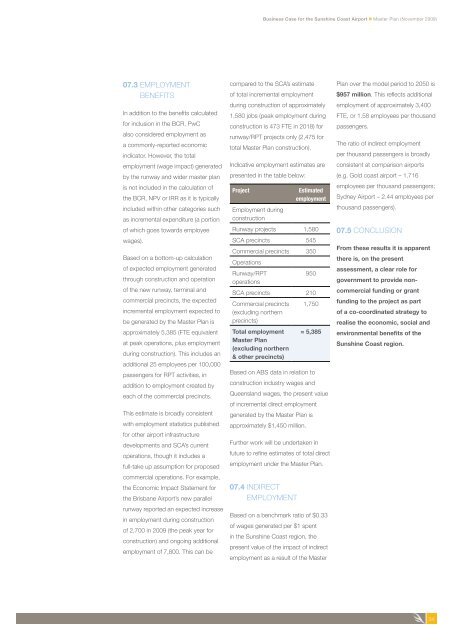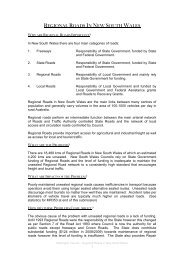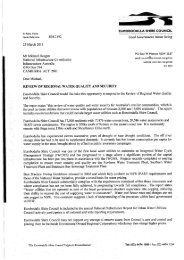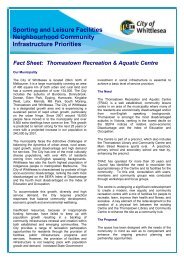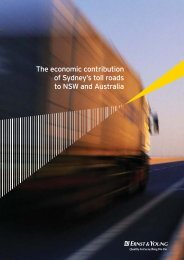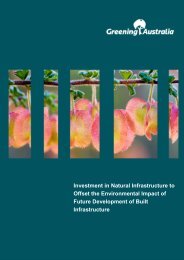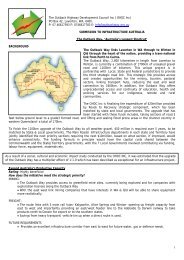Business Case for the SunShine CoaSt airport Master Plan
Business Case for the SunShine CoaSt airport Master Plan
Business Case for the SunShine CoaSt airport Master Plan
You also want an ePaper? Increase the reach of your titles
YUMPU automatically turns print PDFs into web optimized ePapers that Google loves.
<strong>Business</strong> <strong>Case</strong> <strong>for</strong> <strong>the</strong> Sunshine Coast Airport n <strong>Master</strong> <strong>Plan</strong> (November 2009)<br />
07.3 Employment<br />
Benefits<br />
In addition to <strong>the</strong> benefits calculated<br />
<strong>for</strong> inclusion in <strong>the</strong> BCR, PwC<br />
also considered employment as<br />
a commonly-reported economic<br />
indicator. However, <strong>the</strong> total<br />
employment (wage impact) generated<br />
by <strong>the</strong> runway and wider master plan<br />
is not included in <strong>the</strong> calculation of<br />
<strong>the</strong> BCR, NPV or IRR as it is typically<br />
included within o<strong>the</strong>r categories such<br />
as incremental expenditure (a portion<br />
of which goes towards employee<br />
wages).<br />
Based on a bottom-up calculation<br />
of expected employment generated<br />
through construction and operation<br />
of <strong>the</strong> new runway, terminal and<br />
commercial precincts, <strong>the</strong> expected<br />
incremental employment expected to<br />
be generated by <strong>the</strong> <strong>Master</strong> <strong>Plan</strong> is<br />
approximately 5,385 (FTE equivalent<br />
at peak operations, plus employment<br />
during construction). This includes an<br />
additional 25 employees per 100,000<br />
passengers <strong>for</strong> RPT activities, in<br />
addition to employment created by<br />
each of <strong>the</strong> commercial precincts.<br />
This estimate is broadly consistent<br />
with employment statistics published<br />
<strong>for</strong> o<strong>the</strong>r <strong>airport</strong> infrastructure<br />
developments and SCA’s current<br />
operations, though it includes a<br />
full-take up assumption <strong>for</strong> proposed<br />
commercial operations. For example,<br />
<strong>the</strong> Economic Impact Statement <strong>for</strong><br />
<strong>the</strong> Brisbane Airport’s new parallel<br />
runway reported an expected increase<br />
in employment during construction<br />
of 2,700 in 2009 (<strong>the</strong> peak year <strong>for</strong><br />
construction) and ongoing additional<br />
employment of 7,800. This can be<br />
compared to <strong>the</strong> SCA’s estimate<br />
of total incremental employment<br />
during construction of approximately<br />
1,580 jobs (peak employment during<br />
construction is 473 FTE in 2018) <strong>for</strong><br />
runway/RPT projects only (2,475 <strong>for</strong><br />
total <strong>Master</strong> <strong>Plan</strong> construction).<br />
Indicative employment estimates are<br />
presented in <strong>the</strong> table below:<br />
Project<br />
Estimated<br />
employment<br />
Employment during<br />
construction<br />
Runway projects 1,580<br />
SCA precincts 545<br />
Commercial precincts 350<br />
Operations<br />
Runway/RPT<br />
950<br />
operations<br />
SCA precincts 210<br />
Commercial precincts<br />
(excluding nor<strong>the</strong>rn<br />
precincts)<br />
Total employment<br />
<strong>Master</strong> <strong>Plan</strong><br />
(excluding nor<strong>the</strong>rn<br />
& o<strong>the</strong>r precincts)<br />
1,750<br />
≈ 5,385<br />
Based on ABS data in relation to<br />
construction industry wages and<br />
Queensland wages, <strong>the</strong> present value<br />
of incremental direct employment<br />
generated by <strong>the</strong> <strong>Master</strong> <strong>Plan</strong> is<br />
approximately $1,450 million.<br />
Fur<strong>the</strong>r work will be undertaken in<br />
future to refine estimates of total direct<br />
employment under <strong>the</strong> <strong>Master</strong> <strong>Plan</strong>.<br />
07.4 Indirect<br />
Employment<br />
Based on a benchmark ratio of $0.33<br />
of wages generated per $1 spent<br />
in <strong>the</strong> Sunshine Coast region, <strong>the</strong><br />
present value of <strong>the</strong> impact of indirect<br />
employment as a result of <strong>the</strong> <strong>Master</strong><br />
<strong>Plan</strong> over <strong>the</strong> model period to 2050 is<br />
$957 million. This reflects additional<br />
employment of approximately 3,400<br />
FTE, or 1.58 employees per thousand<br />
passengers.<br />
The ratio of indirect employment<br />
per thousand passengers is broadly<br />
consistent at comparison <strong>airport</strong>s<br />
(e.g. Gold coast <strong>airport</strong> – 1.716<br />
employees per thousand passengers;<br />
Sydney Airport – 2.44 employees per<br />
thousand passengers).<br />
07.5 Conclusion<br />
From <strong>the</strong>se results it is apparent<br />
<strong>the</strong>re is, on <strong>the</strong> present<br />
assessment, a clear role <strong>for</strong><br />
government to provide noncommercial<br />
funding or grant<br />
funding to <strong>the</strong> project as part<br />
of a co-coordinated strategy to<br />
realise <strong>the</strong> economic, social and<br />
environmental benefits of <strong>the</strong><br />
Sunshine Coast region.<br />
34


